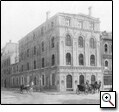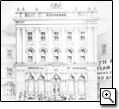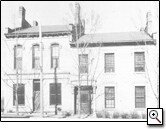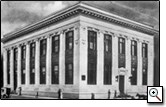The largest merger of two chartered banks in Canadian history
happened on June 1, 1961 - The Canadian Bank of Commerce (established
1867) and the Imperial Bank of Canada (established 1875) merged to form
the Canadian Imperial Bank of Commerce (CIBC). Its history spans nearly
two centuries and is full of adventure and enterprise.
Establishing Foundations, 1867-1895
| The Canadian Bank of Commerce opened for business
on May 15, 1867 in Toronto. The head office and main branch were
located on the corner of Yonge and Colborne streets, in what would
become Toronto's financial district. The Honourable William McMaster, a
prominent Toronto businessman and philanthropist, was the principal
founder of the bank and its first president. Concerned about Montreal's
influence over the economy of Upper Canada, McMaster founded the bank
mainly as competition for the Bank of Montreal. An aggressive
businessman, he rapidly expanded the bank and its network of branches;
by 1874 it had 24 branches, making it the largest bank headquartered in
Ontario. |
|

The Canadian Bank of Commerce Head Office, 1867 |
The Imperial Bank of Canada opened in Toronto on March 18, 1875. Its
original premises were located at 18 Toronto Street, not far from The
Canadian Bank of Commerce. Henry Stark Howland, previously
vice-president of The Commerce, was the principal founder and first
president of the new bank. Having a different philosophy than McMaster,
Howland had resigned from The Commerce because he believed the rapid
expansion of capital and branches was too risky. Still, he was not
opposed to venturing into new territory in search of business.

Imperial Bank of Canada Head Office, 1876
|
|
In 1880, Howland and his vice-president made the
long rail journey to Winnipeg, the capital of the new province of
Manitoba. The men were impressed with the booming western town and
arrangements were made to open a branch, their first outside Ontario.
The Imperial continued its pioneer banking in the West, opening its
first branch in Calgary in 1886 and then in Edmonton in 1891.
During a time when many banks were disappearing, The Commerce and
the Imperial were prospering. By the end of 1895, The Canadian Bank of
Commerce had 58 branches and the Imperial Bank of Canada 18. |
mperial Bank of Canada
Niagara District Bank, 1853-1875
The Niagara District Bank was established in 1853 and began
operations in St Catharines. This was the fourth, and only successful,
attempt to establish a bank to serve the citizens of the Niagara region.
The bank carried on a steady but small business with just 3 branches
and twelve employees. The Niagara District Bank merged with Imperial
Bank of Canada on July 2, 1875. The Imperial Bank of Canada had opened
recently and the purchase of the Niagara District Bank helped the
Imperial establish a position in Ontario. |
|
 |
 |
The Weyburn Security Bank, 1910-1931
The Weyburn Security Company was founded in 1902 to take over the
operations of another company, which had been established to purchase
50,000 acres of land and engage in a large settlement plan. The
Security Company soon began to offer financial services, such as
banking, general insurance and mortgage loans. The business was
successful; however, in order to compete with the chartered banks
operating in the area, it obtained a bank charter under the name Weyburn
Security Bank in 1911. While it continued to operate solely in
Saskatchewan, the bank grew to include thirty branches. Had it not been
for the Great Depression, it may have remained a separate entity.
However, in 1930, it was no longer paying dividends and the directors
were concerned for its continued solvency. On May 1, 1931, The Weyburn
Security Bank merged with the Imperial Bank, which did not have any
representation south of Regina. |
|
 |
 |
Barclays Bank (Canada), 1929-1956
Barclays Bank (Canada) was established in 1929 by Barclays Bank
Limited, a prominent British bank. Because Canadian law required that
all banks operating in Canada be Canadian-owned, Barclays set up an
investment company in Canada, which in turn provided the capital to
start up the new bank. Barclays Bank (Canada) began operations in
Montreal and soon after opened an office in Toronto. With the stock
market crash and the ensuing depression, the bank suffered financially
in its early years. More capital had to be acquired from London in order
to open new branches in urban centres across Canada. World War II and
the resulting foreign exchange restrictions made it difficult to obtain
further capital from England. Consequently the bank decided to approach
the Imperial Bank of Canada about a merger. The Imperial found this to
be a favourable proposal and the two banks merged on February 1, 1956. |
Комментариев нет:
Отправить комментарий